Bedside Table -- November 2022
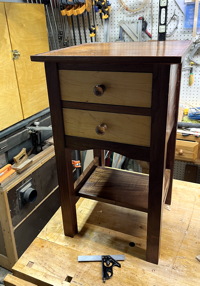
This is a small bedside table of my own design made of walnut and maple from Spacht Sawmill. The finish is linseed oil followed by 3 coats of thinned shellac, then and 2 coats of thinned polyurethane with a 3rd coat on the top and shelf. The table features two drawers which pull from the front, and a fold-down shelf to accommodate extra stuff that doesn't fit well on the top. The shelf is held in place with two rare-earth magnets, and folds down on Brusso brass siderail hinges. The hinges are small, so once down the shelf is also secured in place by two 1/4-20 knobs that fit into threaded inserts on the bottom. Click here to see the shelf open showing the 1/4-20 knob location or here to see it closed, or here to see the a higher resolution image.
Shopkeeper's Stool -- January 2021
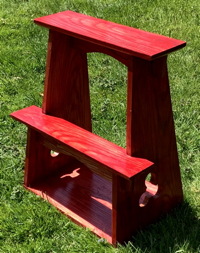
This little stool was written up in Popular Woodworking's Nov 2020 issue as a Japanese Street Vendor Stool. Noting that the project involved canted sides and interlocking stretchers I wondered how it would go together. The answer (3 stretchers later) is, not easily! because, unlike the version in the mag, I chose to dovetail thes sides and bottom. I snapped the stretchers when I tried to put it all together. If you build one, stick to the plan and nail the sides to the bottom! Also, in use, it is not stable if used on carpet, so perhaps change the angle on the front so the first step has more support in front of it as you climb. Nevertheless, here it is, made from ash from Spacht Sawmill. The finish is linseed oil followed by 3 coats of thinned shellac with a red analine dye, then and 2 coats of thinned polyurethane. Click here or here to see higher resolution images or here to see the work in progress.
Bathroom Shelf -- November 2018
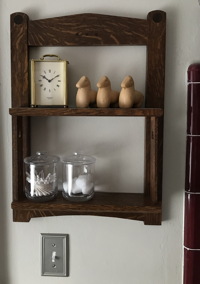
This little shelf was made for our bathroom wall to hold the obligatory jar of q-tips and cotton balls. The quartersawn white oak is from Spacht Sawmill. The finish is linseed oil followed by 3 coats of thinned shellac and 2 coats of thinned polyurethane. Click here to see a higher resolution image.
Medicine Cabinet -- October 2016
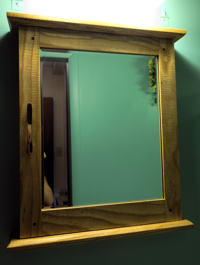
This medicine cabinet was made for Ben and Madeline because their new apartment had just the right hole in their bathroom wall. Taking that as inspiration, this cabinet (made from curly ash from Spacht Sawmill) projects about 3 inches from the wall at top and bottom, but offers about 4 1/2 inches of depth inside. The three shelves are of quarter sawn sycamore. Click here to see a higher resolution image or here to see a closeup of the maker's mark.
Stickley Inspired Plant Stand -- October 2015
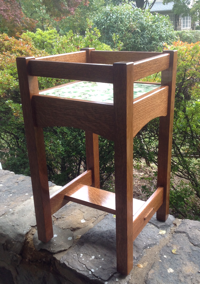
This plant stand is based on one of Gustav Stickley's models featured in Robert Lang's book Shop Drawings for Craftsman Furniture. I departed from the Stickley design by making the lower stretcher into a shelf, and using a stub through-tenon with ebony wedges to secure it. The original featured Grubey tile, while mine has Mexican Talavera tile which I bought at a Crefeld School auction. The piece is constructed of quarter-sawn, white oak purchased from Spacht Sawmill, and finished with linseed oil, shellac and polyurethane. The construction is all mortise and tenon, and to avoid interference at the 90 degree joints, the tenons are chamfered along the inside facing edge. Click here to see a higher resolution image or here to see a closeup of the tile.
First Day School Benches -- March 2015
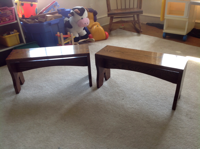
These benches were made to accommodate two little ones each, and are the same height as the seat of the miniature chairs they have in the First Day School room at Old Haverford Friends Meeting. They were made from a single board of white oak and finished with linseed oil, shellac and polyurethane. The tops are dovetailed into the sides and the stretcher has through tenons that are wedged at the sides. To avoid possible splits there is a bow-tie inlay on the inner face of each side just above the mousehole. Click here to see a higher resolution image.
Coffee Table -- June 2013
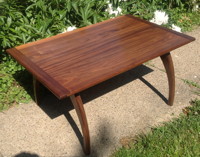
This coffee table was made for my son, Nate. It was made earlier this year in a class I took at Philadelphia Furniture Workshop with Mario Rodriguez and Alan Turner. I just completed the finishing this past week. The finish is thinned, boiled linseed oil, then 3 coats of superblonde, de-waxed shellac thinned to a 1/2 lb cut, then 2 topcoats of thinned, fast-drying polyurethane, followed by a final coat of Briwax. To protect the top from their dogs, I also had an 3/16 acrylic table top protector, but that makes it difficult to see the wood grain. Click here for another view of the top.
Darning Egg -- January 2013
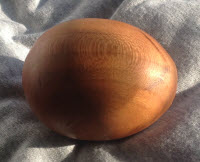
This little darning egg was made for a Friendly Households friend, Susan Christian, who mentioned that her mother had had one. She was going to attend a "schmata" party and wanted a darning egg so she could learn how to repair socks, mittens, and such. I turned it from Pennsylvania black cherry, and finished it by rubbing on some food grade walnut oil. Nothing fancy. I hope it gives many years of service.
Arts & Crafts Medicine Cabinet -- July 2012
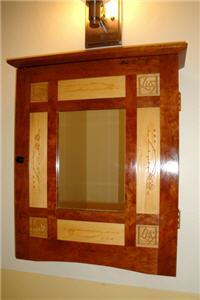
I made this medicine cabinet for our powder room to compliment the Dard Hunter Rose stenciling above the picture rail. The cabinet is made of cherry, cherry veneer plywood for the back, basswood for the chip-carved panels, ambrosia maple for the shelves, and ebony for the knob. The cherry is from Spacht Sawmill, and the maple courtesy of Alan Turner. In the view from the bottom, you can see that I dated the carcase 2010, but it took me a while to learn to carve the panels. Then, when I did the glue up for the door, because of the extra mortise and tenon joints on the muntins and mullions, I ended up getting it not quite square. Fortunately, I�d used hide glue, which with a bit of heat can be remelted. I used heating pads to soften the glue, then clamped it to a square frame, and this corrected most of the problem, though it�s still off by about 1/8" over the 20" width. The close mechanism is a ball catch from Brusso, and the hinges are 2" by 1.5" Brusso full-mortise hinges. As you can see, I was trying to pick up the Dard Hunter Rose pattern stenciled above the picture rail in the carved panels. The knob is turned from Gabon ebony. The carcase is dovetailed at the top, with an overhanging top screwed to the top panel. The bottom is fitted into the carcase in sliding dovetail joints. The plywood back fits in a groove inset 1/4" from the back. The mirror is 1/4� thick glass which makes the door quite heavy and there is a 1/2" bevel at the edge. The finish is boiled linseed oil, followed by 3-5 coats of thinned super-blonde de-waxed shellac, and then 2-3 coats of thinned, fast-drying polyurethane on the outside of the cabinet and the shelves. The cabinet was hung using a "French-cleat" which is just a board cut in two pieces at an angle with one half screwed to the wall and the other to the back of the cabinet. The plan was done in SketchUp and can be downloaded here.
Shaker Style Step Stool -- May 2012
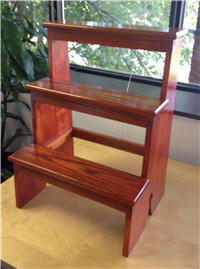
This is an adaptation of the Shaker StepStool in Ejner Handberg's shop drawings book. It is constructed of pine and red oak from Spacht Sawmill. The steps and cross braces are red oak and the sides are three planks of pine joined with biscuits. I didn't trust the edge joint, since the Shakers would have used a single pine plank for this and I was using a joined panel, I was worried that it might fail. For that reason I changed the half round cut-out at the bottom to a mouse-hole that allowed the center panel to be supported all the way to the floor. I also ran an oak strip on the inside that spanned all three panels. I made this for my friends at WAM who needed a step stool to access the upper shelf of the supply cabinet. Click here for high resolution or the SketchUp plan.
Stickley Round Taboret -- October 2010
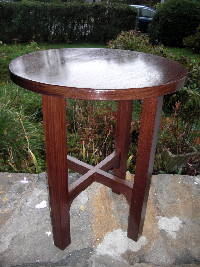
This is a reproduction of the Gustav Stickley #603 Round Taboret, made as a wedding gift for Caitlin Rooney and Gary Merto, who were married on the 1st of May. Took me a while to complete it, but it is made from black walnut from Spacht Sawmill. The top is made from three planks cut from a single board and is a bit over 7/8 inch thick. The legs are joined by corbel stretchers below that have a pegged tenon into each leg, and the top is attached to stretchers that are dovetailed into the legs. The overall size is 18 inches in diameter and about 20 inches high. The plans are Shop Drawings by Robert Lang. The finish consists of 4 coats of amber shellac, followed by 3 coats of thinned polyurethane varnish and a top coat of wax that has been rubbed out with #0000 steel wool and buffed. Click here to see the inscription and maker's mark, and click here for medium resolution or high resolution.
French Doorstops -- November 2009
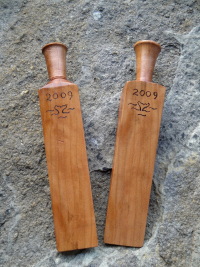
This pair of French doorstops was turned from a single block of black cherry. They are about 8" long. The handles on each end are turned, and then the block is cut along a diagonal and planed before finishing. Finishing consists a Boiled Linseed Oil and 3 coats of shellac. These were made for this year's Crefeld Auction and brought $35 for the pair. Click for a hi-res image.
Hancock Shaker Bench -- November 2009
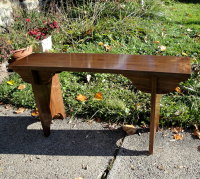
This is the Hancock Shaker Bench, made as a wedding present made for Graedon & Kelsey, who got married in July this past summer. The construction is from a single board of black walnut I purchased from Dave Spacht. The finish is Boiled Linseed Oil, followed by 4 coats of thinned, (about 1/2 lb cut) blonde, dewaxed shellac, followed by a top coat of thinned polyurethane. While I had hoped to have this done a few weeks after their wedding, I broke my leg while on vacation and could not get down to my shop for about two months. Hopefully, they'll think it was worth the wait. Click here to see the curly figure of the walnut. Since Dave doesn't steam his walnut you get all the rich colors along with the chocolate brown, even some purple highlights. Click for a hi-res image.
Donation Box -- July 2009
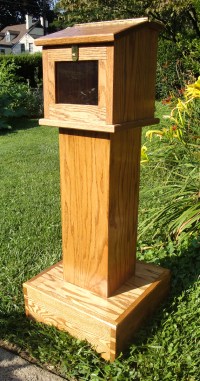
This is a "donation box" made for the Burlington Friends Meetinghouse, where my wife, Carol, was the director. Since the meetinghouse has been closed to the public, the box has been moved to Old Haverford Meeting. The box features 1/4 inch thick acrylic windows, and a money slot, and the base features through dovetails. The construction is from red oak which I purchased from Dave Spacht, and a bit of red oak plywood leftover from one of Ben's projects. The finish is Watco Dark Walnut oil, followed by two coats of 1lb cut shellac, and a coat of polyurethane thinned with mineral spirits. Click for a hi-res or med-res image.
Stickley Shaving Stand -- June 2009
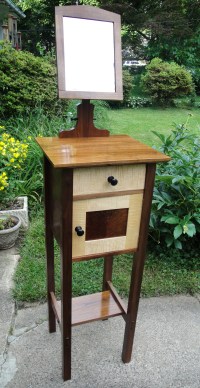
This piece is based on a Gustav Stickley design first published in The Craftsman and available today in the Dover edition Making Authentic Craftsman Furniture. This version is made of walnut, curly maple, hard maple, and ebony. The project began with an offcut I was handed at the Philadelphia Furniture Workshop when I made the Hearth Bench project discussed below. When I resawed the offcut near the knot, a gorgeous burl with a tight, curly figure was revealed. Bookmatching this, I imagined this Demon in the Wood as the focal point for this piece. I then purchased some black walnut and curly maple to begin the project. When it came to the knobs, I decided on ebony, but couldn't locate a source for purchasing stock knobs and pins, so I took the turning class at PFW to learn how to make my own. The top features a mirror on a post, that can be adjusted to different heights using a turned ebony pin. The drawer front is curly maple, with half-blind dovetails and provided with a turned ebony pull. The construction is typical for a Stickley piece with through-tenons that are slightly proud of the legs and stretchers, and locked in place with ebony wedges. Click for a hi-res or med-res image.
Lathe Bench -- February 2009
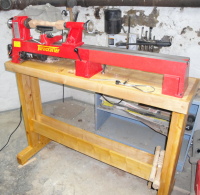
This piece is similar in design to the Joiner's Bench I built at PFW, in that it has a double trestle arrangement for the legs. The trestle tenons are wedged through-tenons. The material, unlike the workbench, is just ordinary pine. The legs are pairs of 2x4"s that were jointed, planed, and then glued together. The mortises were cut while they were still in two pieces, using a dado stack in the table saw. I recently took the turning class at PFW and have since used this lathe to make small parts for furniture. Click for a hi-res or med-res image.
Shaker Silverware Tray -- Oct 2008
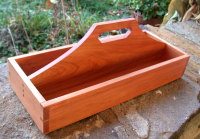
This piece is based on Ejner Handberg's shop drawings of Shaker woodenware and recently described by Christopher Schwartz in Woodworking Magazine. The originals used cut nails, but mine uses dovetails and dowels. The piece is made entirely from a single board of Pennsylvania Black Cherry (except for the walnut dowels), and is finished with linseed oil and paste wax. The bottom panel features my Maker's Mark. Click here to see the pegged handle. It was made for this year's Crefeld School Auction. The final price was $100 ... a bit less than I was hoping for, but the purchaser kindly bid $50 over the initial opening bid, so at least they must have liked it. Let's hope for better luck next year. Click for a hi-res or med-res image.
Frame for Craftsman Porch Lantern -- Jul 2008
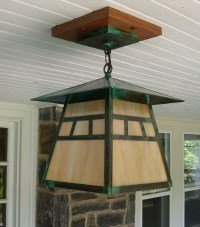
The only woodwork in this is the mitred frame, made of white oak, finished with amber shellac (2 coats) followed by marine spar varnish (2 coats). The screws are hidden by pyramidal walnut plugs that stand just proud of the surface. The beautiful lantern is not my work, but was made by Craftsman Outdoor Lighting and features a bronze verdigras finish and art glass panels. This was a combination Father's Day / Birthday present from Nate, Ben and Connor. Thanks, boys! I think it really compliments our Craftsman style house.
Stickley 802 Side Table -- Dec 2007
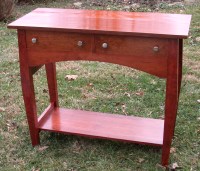
This is a reproduction of Gustave Stickley's #802 Sideboard, which I made for my sister. The piece is based on the Shop Drawings by Robert Lang. There are several modifications, most notably the removal of the backsplash, which Linda wanted. There is also an interior frame is not in the original, but I made the error of departing from the Harvey Ellis design in that I tried attaching the arched front apron with biscuits, which are not strong, and this joint failed when I put some stress on it. The interior frame is 3/4 x 1-1/2" poplar, and now carries the tensile load that the apron would have carried, and is attached to the leg sets and the front apron by glue and screws. Click here to see the interior frame or click here to see the hi-res image. The drawers feature handcut dovtails. Here is a photo of the finished piece in Linda's Dining Room. The finish consists of an initial coat of Boiled Linseed Oil, followed by Olympic Merlot Stain, with some Lockwood Red dye brushed onto the wet oil stain and rubbed out. After that dried for a week, it was followed by three coats of Zissner "amber" shellac, thinned to about 1/2 lb cut. That was followed by four coats of polyurethane (Minwax "fast-drying") thinned 1:1 with turpentine with a few drops of Japan Dryer. All coats are wiped on, allowed to dry overnight, and scuff sanded before the next coat. The top has a fifth coat of varnish. The final step was to rub out the gloss on the varnish with Butcher's Amber paste wax on 0000 steel wool, followed by final buffing.
Shaker Candle Box -- Nov 2007
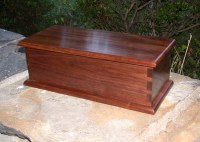
This shaker-style candle box is based on the drawing in Ejner Handberg's Shop Drawings of Shaker Furniture & Woodenware, Volume 2. It was made for this year's Crefeld Auction, out of local black walnut from Spacht's sawmill. The box features handcut dovetails and a hinged lid with a thumbnail profile on three sides. The base has a similar profile and was attached only in the middle of the two sides with glue and dowels from the bottom face, to allow for wood movement. The finish is boiled linseed oil, followed by five coats of thinned shellac, with a topcoat of paste wax that has been rubbed out with steel wool. The winning bid at the Crefeld Auction for this piece was $150. Click for a hi-res or med-res image.
Doorbell -- Jun/Jul 2007
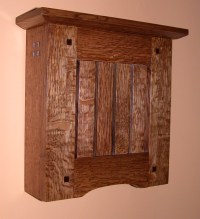
This Arts & Crafts style Doorbell Cover houses an electronic doorbell unit. It is constructed of 3/4" and 3/8" quarter-sawn white oak except for the square pegs which are made of black walnut. Both are leftover wood from the octagonal table. The finish is Watco Dark Walnut Oil, followed by 5 coats of amber shellac, followed by a coat of dark Briwax. Click for a hi-res or med-res image.
Octagonal Taboret -- Feb 2007
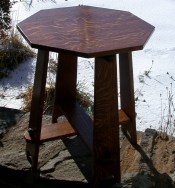
This 24" high, octagonal taboret is one of the projects in Popular Woodworking's book Authentic Arts & Crafts Projects. It is a "knock-down" piece in that the legs are held in place by pegged, through-tenons. It is constructed of 3/4" quarter-sawn white oak which I purchased from David Spacht's mill except for the pegs which hold it together, which are made of black walnut. Click here to see a detail of the peg, which was ebonized using a method described by Alan Turner, in which one dissolves steel wool (or other iron) in vinegar, then coats the wood with this solution, thereby forming ferric tannate, when it reacts with the tannin in the wood. These pegs are also used to fasten the upper stretchers. The finishing method was mostly taken from one described in the Spring issue of Woodworking Magazine. I started by smooth planing, then orbital sanding with 120 grit, then hand scraping, then 220 grit, then hand scraping again, then hand sanding with 320 grit. Next I raised the grain with water, and sande again with 320 grit. Next I applied a water based stain of dissolved Van Dyck (walnut) crystals. After that I followed the magazines method of Minwax (they recommend Olympic) Special Walnut stain, Watco Dark Walnut oil, followed by amber shellac. I used 3 coats of thinned shellac and the top has a polyurethane coat for added toughness. Click here to see the before and after finishing high-res images.
Crosscut Sled -- Jan 2007
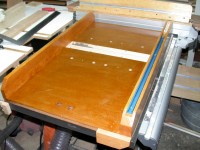
This crosscut sled is a composite of the design found in Jim Tolpin's book Table Saw Magic and suggestions from Alan Turner. The sled bottom is 3/4 inch MDF and slides on two Incra adjustable mitre track runners, and the fences are of straight-grained ash, with a leading fence that is 4" high by 3/4" thick, and a trailing fence that is 3-1/2" x 1-1/2". The rear (trailing) fence is glued up from two 3/4" boards and capped by a third piece of the same stock, slotted to accommodate a t-track (planning to buy a 36" piece soon!). The trailing fence also has several through-holes to attach sacrificial fences and temporary jigs with 1/4" bolts. Also made of ash, is a replaceable insert that spans the area of the saw kerf. I made a plywood template first with which to locate and predrill the screw holes, which hopefully won't get lost in my shop. The ash was supplied by David Spacht's sawmill. Note the stop block on the left edge, which protrudes below the saw table surface. It butts into a block clamped to the edge of the table, to prevent overshooting the point at which the blade exits the back of the rear fence. I plan to add a blade guard to this area made of lexan.
Candle Box in Walnut -- Dec 2006
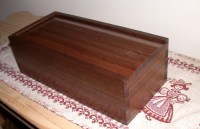
This is similar to the cherry version I made in October, but is longer to accommodate 10 inch candles, and of course is made from black walnut, rather than cherry. This was a Christmas present for my wife, Carol, who wanted to know after the other one was sold at auction if I would make one for her too.
Piano/Hearth Bench -- Oct/Nov 2006
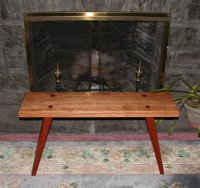
This bench is made from a slab of white oak, with tapered mahogany legs, The project was taught by Alan Turner at the Philadelphia Furniture Workshop, in conjunction with the Main Line School Night. (Click here to see a class photo. Alan is in the middle.) Alan provided the rough lumber which was milled to 1-1/2" thick and 9" wide. The mahogany legs are joined to the bench top with through tenons, wedged with rosewood. Before assembly, the wood was surfaced using machinery, then a hand smooth plane and a hand scraper then sanded with 220, 320, and 600 grit. The wedges were inserted into saw kerfs in the through tenons to lock the legs in place The legs were then marked and cut to produce a bench height of 19-1/2" which is taller than Alan's regular hearth bench, but is better for use as a piano bench. The finish shown consists of thinned, Boiled Linseed Oil, cured for 5 days, followed by multiple coats of polyurethane varnish. When this has had a few weeks to cure, I plan to apply a pastewax top coat and rub the high gloss out to a medium satin finish. Click to see in hi-res or med-res.
Colonial Candle Box -- Sep/Oct 2006
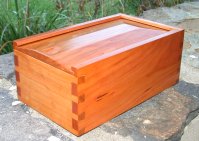
This colonial candle box is made from Pennsylvania cherry end cuts that were "freebies" from David Spacht's sawmill. (Spacht Sawmill, Fairview Village PA 610-584-1855). It is sized to hold 3x5 recipe card in case you don't feel the need to keep 9" tapers handy anymore. Unlike the jewelry box below, this time the cherry was planed to 1/2" thickness. Joinery is handcut dovetails. The top was chamfered on three edges with a table saw cut set to about 8 degrees, using a tenoning jig. A finger pull was carved into the top just using a bench chisel (a gouge might have been nicer.) The parts were smooth-planed, then sanded with 220, 320 and 600 grit, followed by two doses of boiled linseed oil to bring out the figure. The top coat is shellac rubbed out with paste wax. This piece was donated to the Crefeld School for their annual auction (Nov 4) and the winning bid was $100.
Taper Jig for Table Saw -- July/Aug 2006
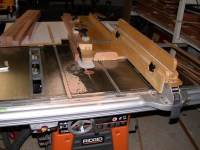
This is based on the jigs shown in Jim Tolpin's Table Saw Magic book, adapted to the fence of the Rigid TS3650. There are three main components: a sled with a maple handle and a runner on the right side that rides against the fence; an auxiliary fence that bolts onto the fence and captures the runner of the sled; and a slotted workpiece holder, which has an extended foot and hold-fast clamps to keep the work in place. In this view, I've just cut a nice cherry wedge off a leg for a Stickley 802 reproduction piece that will appear here in completed form, one of these days.
Outfeed Table for Table Saw -- June 2006
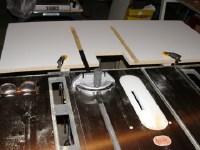
This project may be of interest to other owners of the Rigid (tm) TS3650 Contractor-style Table Saw, and so I've decided to document it here. This photo shows the nearly completed outfeed table, which is supported by two 30" steel L-channels that were attached to the upper left and right sides of the saw body, and by a pair of hardwood legs supporting the back end. More photos and discussion of how to make it is available here.
CD Case -- May 2006
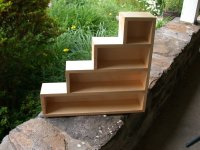
This project was started when I botched a dado in a large piece of 3/4 birch plywood. Measuring what was left on either side of my error, I settled on this design which has horizontal shelves of 6" (top), 12", 18", and 24", with a 5" spacing. The shelves and verticals are all biscuit joined, with a single #10 biscuit at each joint. The finish is 3 coats of Bullseye Shellac (thinned a bit), followed by a topcoat of wax rubbed out with 0000 steel wool. The case has a back cut from 1/4" birch plywood, and is designed to hang on the wall using a "French cleat." If I were to do this over again, I would have provided a rabbet edge for the back side plywood to be inset, so as to make the case hang closer to the wall. I might also add edge banding to hide some of the small voids in the plywood layers visible on the front edges. Next time! Click to see in hi-res or med-res.
Footstool -- May 2006
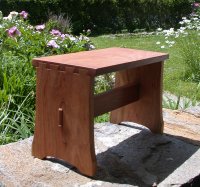
This project was taught by Alan Turner at the Philadelphia Furniture Workshop, in conjunction with the Main Line School Night. Alan provided three pieces of cherry about 3/4" thick and 10" wide, and another about 2.5" wide for the stretcher. The half-blind dovetails and the wedged, through-tenon were cut using handtools, though the curves on the leg sides and bottom were pattern-routed. Before assembly, the boards were surfaced using an E.C. Emmerich Primus Wooden Smooth Plane, then sanded with 220, 320, and 600 grit. The parts were assembled with hide glue, then maple wedges were inserted into saw kerfs in the through tenons to lock the stretcher in place. The finish shown consists of Bartleys Gel Stain on the top and stretcher, followed by Boiled Linseed Oil (thinned), and rubbed out. When this has had a few weeks to soak in, I plan to apply shellac and a pastewax top coat. Click to see in hi-res or med-res.
Jewelry Box -- April 2006
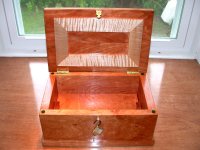
Not to be outdone, Ben decided to make a jewelry box for Becca, using some freebie cherry from Dave Spacht (Spacht Sawmill, Fairview Village PA 610-584-1855). The joinery is entirely done with a Porter Cable Biscuit Joiner, with the exception of the cherry trim which hides the birch plywood base, which is attached with dowels. Ben did the design, and assembled and sanded the parts, while dad did the machine tool operations and applied the finish. The finish consists of Boiled Linseed Oil (thinned), and rubbed out, followed by Jeff Jewett's paper towel varnish method using 7 coats of thinned fast-drying polyurethane varnish. Click to see in hi-res or med-res.
Garden Trellis -- April 2006
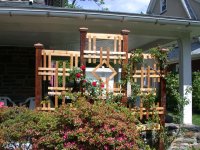
This project was designed last fall, and constructed over the winter. It is made from 4x4, 2x4, and 2x6 Red Cedar from D.M.I. Home Supply in Ardmore PA. The 2x6 lumber was resawn to obtain the lattice strips which ended up 1/4 x 1-1/2" x 3 or 4 feet. The 2x4 cross members were joined to the 4x4 posts using mortise and tenon joinery, with the tenons being 3/4 x 1-1/2 x 3". The diamonds are a double thickness of the lattice, mitred on the front, but not the back. Here are more pictures of installation. Click to see the roses in hi-res or med-res.